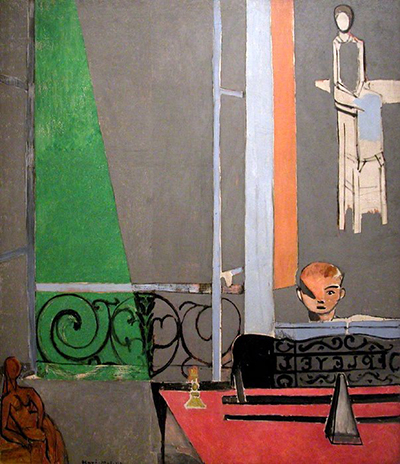Henri Matisse painted the piano lesson in the summer of 1916. It is oil on canvas, 245.1 × 212.7 cm painting structurally, timbral, and intellectually satisfactory. The image portrays the living room of his house in Issy-Les- Moulineaux, a suburb just slightly southwest of the heart of Paris with his elder son, Pierre, younger than he would have been in 1916, at the piano.
His 1908 bronze nude female sculpture titled decorative figure sits at the bottom left-hand corner, and, at the top right corner, hanging on the wall is his 1914 geometric painting of a woman sitting rigidly on a high stool. The rest of the canvas is concrete gray but juxtaposed with color images and linear forms. The gray space can be a bit confusing at first. However, it seems to be a stern, distant, aloof instructor looming behind Pierre, Matisse's son, who is so attentive and glances furtively from behind the piano's curved music rack with the brand name "PLEYEL' which is read backward according to the painting. He created variations on themes that he had already created.
Matisse began with a naturalistic drawing, but he eliminated details as he worked, scraping down the minutiae and reworking with different colors, leaving only the essentials. Henri Matisse composes this significant painting just as a musician would a piece of classical music by performing a harmony within instrumental music rather than sung by voice, which exemplifies Matisse's concept of concord of tone. The whole arrangement of the picture is like an allegory for art-making, which requires an expressive balance between emotional expression and intellectual understanding.
The image elicits a specific moment – a ray of light swiftly illuminates in a dark interior-by the triangle of shadow on parts of the boy's face and the contrasting green triangle of light reaching across the empty sumptuous lawn outside. The grilles of the lovely French window frame engraved by dots, circles, and flicks on the left side portray the eroding effect of light. A theme emphasized by the presence of that instrument of the devil, popularly known as the metronome, echoed on his face and the burning candle reflected on the piano.
The piano lesson is an organic geometric painting. However, the juxtapositions and linear forms hint at traces of cubism. Matisse often expresses how he feels about life through his exquisite paintings. The piano lesson is created as a painting and as a painting of a sculpture. The piano lesson painting by Henri Matisse is hanged at the museum of modern art, New York City.




